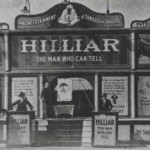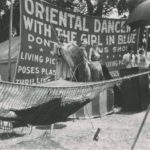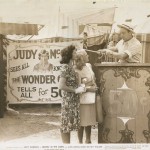The Monkey Girl
The Story Of Percilla Bejano
“Being Different” Percilla/Emmett Interview from Big Chief Studio on Vimeo.
Percilla Roman The Monkey Girl, was born in Bayamón, Puerto Rico, on April 26, 1911. At birth, she had not only a full head of dark hair but also a layer of coarse dark hair covering her entire face and body. She also had two rows of teeth. Of her parents’ seven children, she was the only one with any sort of abnormality.
Her parents brought Percilla to New York City several times in hopes of finding the cause and cure for her condition. The experts agreed that it was the result of a genetic abnormality and could never be cured. Frustrated, and in need of funds to support his wife and other children, her father placed her on exhibition when she was three years old. When she was six, her father died and the show’s owner, Carl Lauther, and his wife adopted Percilla.
The Lauthers were as much doting parents as they were managers. They hired tutors to ensure Percilla got the best education. (She was already fluent in Spanish and English from living in Puerto Rico.) When Percilla complained of being lonely, they bought her a pet: a trained chimpanzee, Johanna, who would be Percilla’s constant companion, on and off the stage, for years to come.
Billed as “The Monkey Girl”, Percilla became a great success with Rubin and Cherry Shows, where Carl Lauther ran a freak animal exhibit, “Lauther’s European Wonder Show”. She was especially popular with spectators in 1924, in the wake of the famous Scopes “monkey trial” which brought the debate over evolutionary theory into the public eye. Who better to personify the issue than a living, breathing Missing Link? (Krao, G.A. Farini’s “missing link”, was still performing, but had been relegated to the role of a simple Bearded Lady at Coney Island.) Percilla and a trained orangutan, Snooky, even staged a mock debate, with Percilla Bejano The Monkey Girl representing the pro-evolution argument and Snooky standing against it.
In 1936 Lauther’s show, starring Percilla as well as three Ubangi tribeswomen with Captain White was signed with the Johnny J. Jones Exposition’s “Oddities of the 20th Century” show.
That is when she met the love of her life, Emmitt Bejano, known as “Lobello, the Alligator Boy”.
He was born Emmitt Driggers in Punta Gorda, Florida, on August 23, 1914. His parents divorced when he was six years old and his father put him on exhibition with showman Johnny Bejano of Morris & Castle Shows. When Emmitt’s father died, Bejano adopted him. Emmitt was afflicted with lamellar ichthyosis, a hereditary condition that causes thickening and cracking of the epidermis that resembles reptilian scales. By constantly oiling his face and hands, Emmitt was able to keep these parts scale-free and go unnoticed in public wearing long sleeves and a high collar.
Emmitt and Percilla felt an instant attraction and, after a few months courtship, eloped in January of 1938, to escape Lauther’s protective nature.
They returned to the stage and became known as The World’s Strangest Married Couple.
On February 2, 1939, Percilla gave birth to a baby girl, Francina, at Millers Tavern, Virginia. Like Percilla, Francina was covered head-to-toe in black hair. The World’s Strangest Married Couple was overjoyed but sadly Francina succumbed to bronchial pneumonia at the age of just fourteen weeks.
In 1945 Percilla and Emmitt – as “Londo and Lobello” – left Lauther’s show and signed on with a traveling Ripley’s Believe it or Not?! exhibit. Among their colleagues were Joan Whisnant Beach, armless guitarist; Clara “Dolly” Regan (then Clara Schazer), the ossified girl; Grace McDaniels, the mule-faced woman; and W.D. “Tiny” Cowan, one of America’s fattest men.
Sometime in the 1950s, Emmitt and Percilla bought property in Gibsonton, Florida. Desiring children, but fearing another tragedy, the Bejanos chose instead to adopt a baby boy, Tony, in 1960. Percilla nicknamed their homestead the P.E.T. Ranch – for Percilla, Emmitt, Tony. Tony traveled with his parents and worked as a ride operator and concession man with the carnival.
Throughout the ’50s and ’60s, they ran their own show, known as the Bejano Family, with Gooding Amusements, and they performed with James E. Strates Shows into the 1970s, even as freak shows across the nation faced closures by well-intentioned disability groups. “We have fun in our work and we often feel that some of the people at the show need to be up on the stage looking down on us,” Percilla Bejano The Monkey Girl, told a reporter in 1978. “When they start making fun at me, I say, ‘I can see you for nothing right here, but you had to pay to see me.
Percilla and Emmitt worked together for Ringling Brothers and other shows for a number of years. However, after spending several decades in the business the couple retired to a life away from prying eyes — whereas Percilla put it, “The show’s over.”
“[Sideshow work] keeps me off the relief line,” Emmitt said in the same interview. “It’s an honest effort, and I feel more or less proud of the fact that I can earn my own living and can do anything anybody else can. Nature does funny things sometimes, but I’ve lived a normal life.”
In the 1980s and ’90s, Percilla and Emmitt retired from traveling, but made numerous television and film appearances as two of the last surviving veterans of the intriguing, yet increasingly taboo, freak show culture. The 1981 documentary Being Different features an interview with the couple and footage of Percilla in the supermarket with her heavy black beard covered by a veil. (If anyone asked, she told them she was “a Hindu”.)
Percilla and Emmitt enjoyed many years of restful retirement together at their home in Tampa. Their long romance ended with Emmitt’s death in 1995.
On April 17, 1995, Emmitt passed away. In mourning for her husband of nearly sixty years, Percilla began shaving her beard. Though she continued to make public appearances, she remained beardless until her own death on February 5, 2001.
I’ll grant my exterior appearance is strange and unusual but that does not hinder me from enjoying life to the fullest extent and from participating in the goodness life has to offer the same as yourself.
– statement from one of Percilla’s pitchbooks



